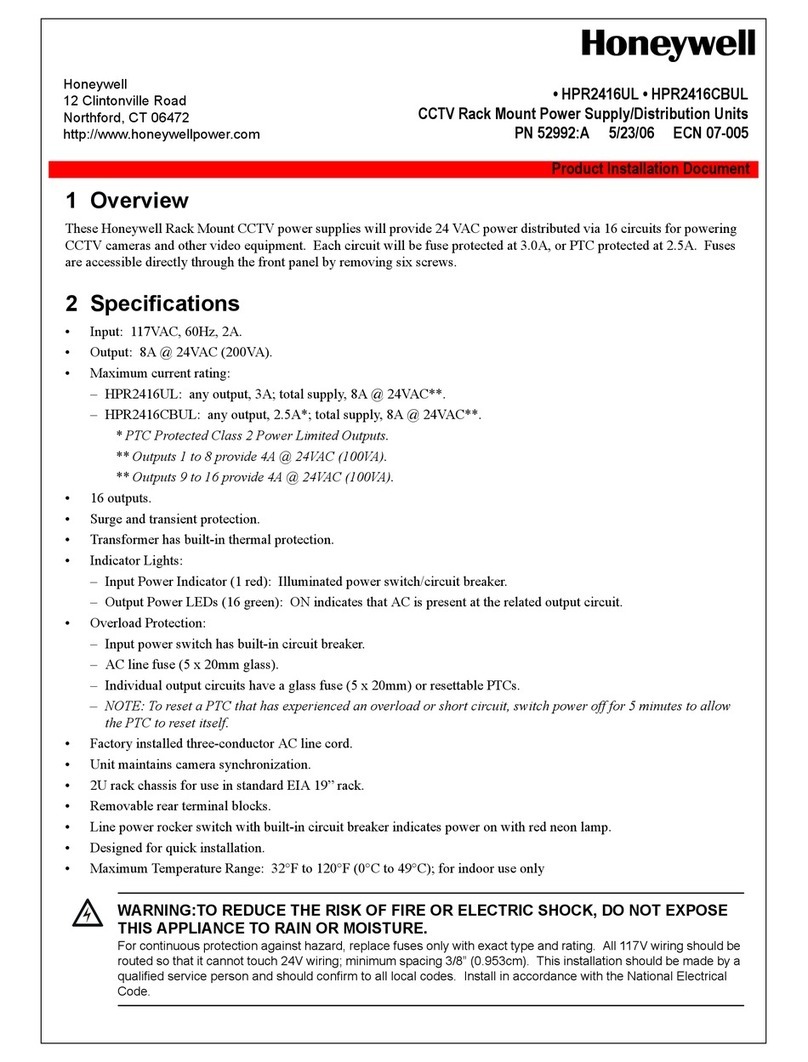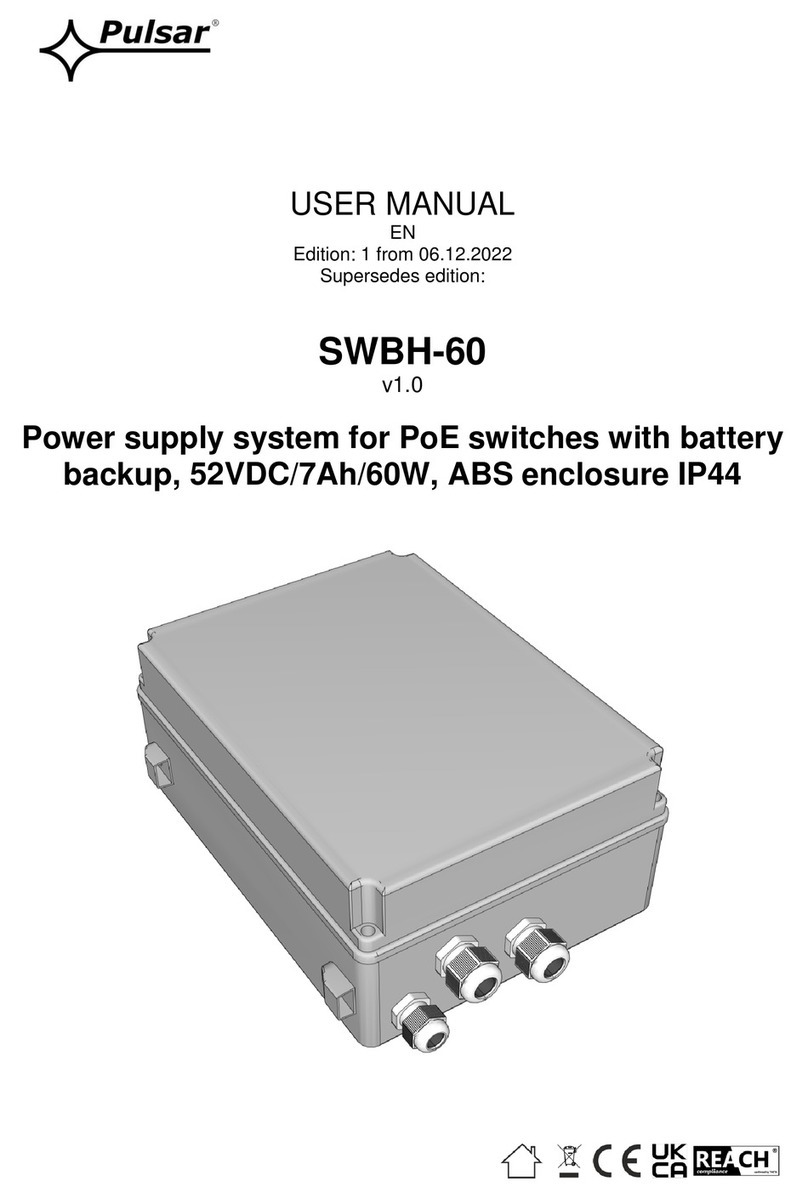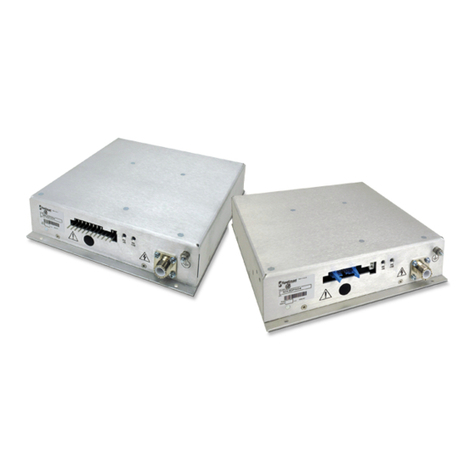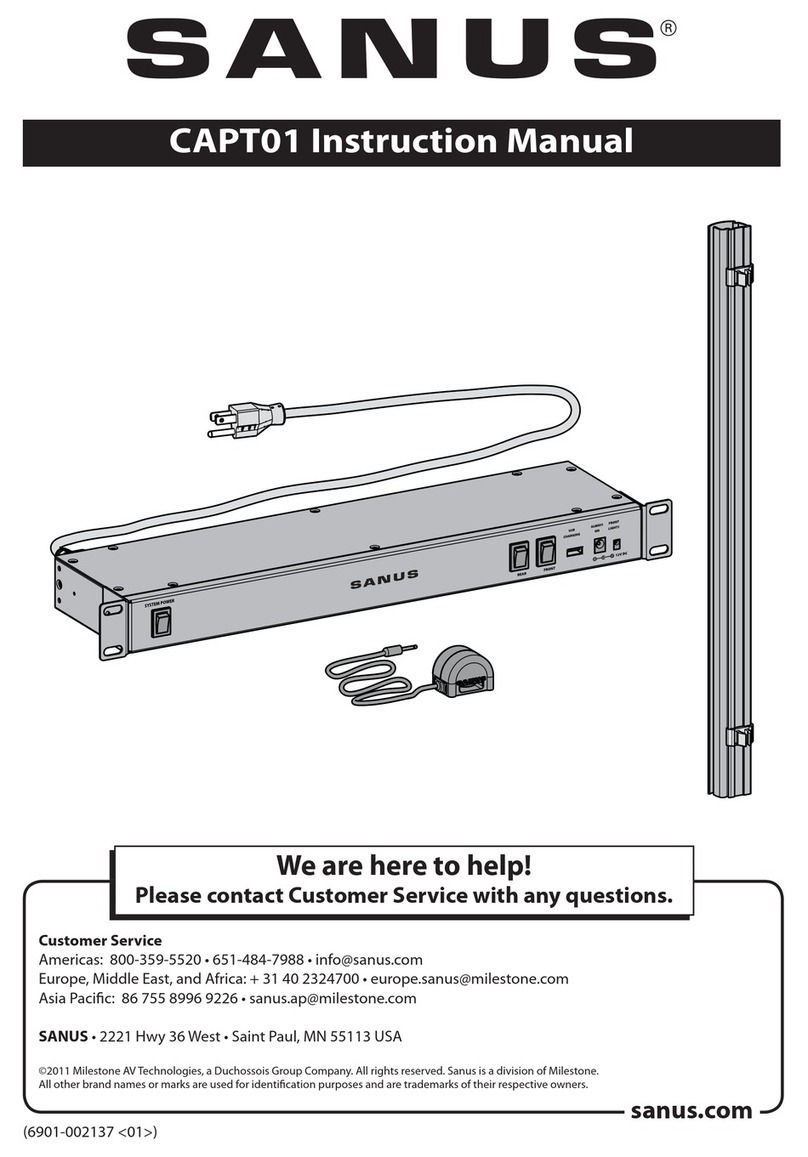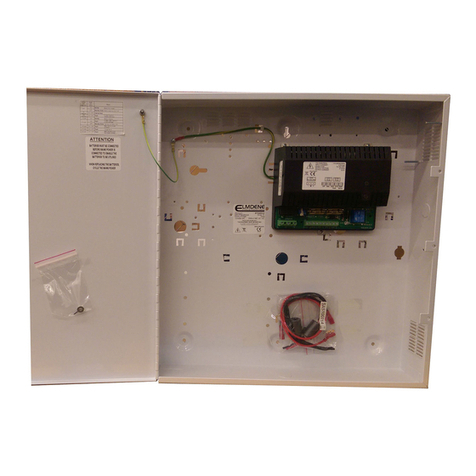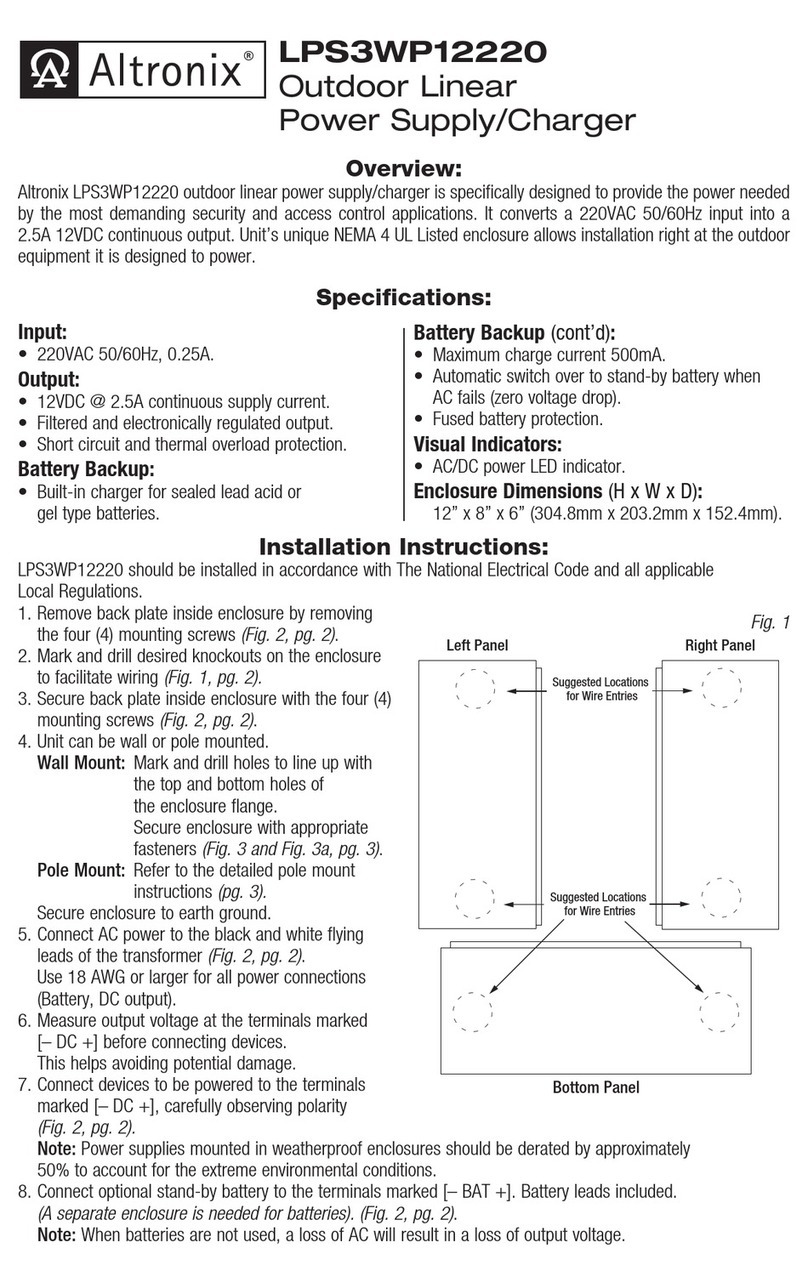Federal Signal Corporation SelecTone PS250 User manual

255315C
Rev. C 801
Printed in U.S.A
Model PS250 SelecTone®
Standby Battery Backup/Power Supply
Installation and
Maintenance Instructions

-1-
INSTALLATION AND SERVICE MANUAL FOR
FEDERAL MODEL PS250
I. GENERAL DESCRIPTION.
A. General.
The Model PS250 Power Supply is a nominal 12 VDC or 24 VDC power supply that provides
primary power and/or standby power to various devices in a SelecTone system while maintain-
ing the charge level of an integral 24 volt battery package (refer to page 3). The battery pack-
age automatically supplies power during power outages. Once power is restored, the supply
recharges the batteries.
This power supply is intended for use in applications requiring UL certication for re protec-
tion signaling and access control. The power supply must be installed in accordance with the
National Electrical Codes and in accordance with NFPA 72 (protective signaling systems). This
power supply meets UL certications 1481, 603, and 294.
The power supply converts 120 VAC @ 50/60 Hz, or 240 VAC @ 50/60 Hz, into a fully regu-
lated 12 VDC or 24 VDC output. The unit has 2.5 ampere capacity and the output is protected
by a poly switch (PTC). This supply is equipped with thermal and short circuit protection with
auto reset.
The power supply has green and red LED indicators mounted on the printed circuit board of
the unit. The green LED, when lit, indicates the presence of AC power in the unit. The red
LED, when lit, indicates the presence of DC power in the unit.
The unit is housed in an enclosure designed for permanent mounting on a wall or another sub-
stantial vertical surface. An optional key lock door is supplied for the front door of the cabinet,
the lock is provided to discourage unauthorized access. The unit is intended for indoor use
only.
B. Battery Package.
The PS250 battery consists of two 12 volt, sealed lead acid batteries, connected in series. These
batteries supply emergency power to units in a SelecTone system or other devices during elec-
trical power failures. The power supply includes a built-in charger for the batteries.
The length of time that the batteries can supply power depends upon the amount of current
drawn by the loads. In normal re alarm systems, the two time frames used are; twenty-four
hours or sixty hours on standby, followed by ve minutes of alarm.
It is necessary for the power supply to have enough capacity to operate the external equipment
properly. Calculate the standby current and the twenty-four hour discharge rate on standby,
or the standby current and the sixty hour discharge rate on standby. Determine the total am-
pere-hour capacity necessary as described in
the following example.
EXAMPLE:
Discharge Rate: 24 hours
Standby current: 0.120 amperes, 24VDC
Five minutes Alarm Current: 1.2 Amperes, 24VDC
Useful Battery Capacity: 85%
Capacity Req. = {(dis. rate (hours) x standby current (amps)) +
(alarm hours(hours) x alarm current (amps))}/useful bat. cap.
Capacity Req.: {(24x0.200)+(5/60x2.5)}/0.85
= {4.80 + 0.20833}/0.85
= 5.008/0.85
= 5.89 Ampere-Hour
For this example, a 24VDC, 2.5 Amp., power supply with 24V, 7 Ampere-hour battery can op-
erate the signaling device.

C. Power Supply Circuit Board Assembly.
The power supply printed circuit board contains circuitry that provides DC operating voltage
to units in a SelecTone system and maintain a charge level on the batteries when AC power is
available. It also includes logic circuitry that controls the AC power LED, DC power LED and
transfer of battery connection to the output during an AC power outage.
II. SPECIFICATIONS.
Determining the maximum load discharge current from a specic battery size over a specic
amount of time can be tricky. Batteries are rated at maximum efciency over a 20 hour discharge
period. Therefore, a 20 amp-hour battery will provide 1 amp over a 20 hour period. However,
calculating discharge time for other discharge currents is not as easy as division or multiplication.
A 20 amp-hour battery will supply 1 amp for 20 hours. However, it will not provide 2 amps for 10
hours, but rather, 1.8 amps for 10 hours, which is equivalent to 18 amp-hours.
EXAMPLE:
Your system has a 12 amp-hour battery and you need 4 hours of backup time. Simply locate the
12 amp-hour diagonal line and the 4 hour horizontal discharge time line. Next, nd the intersec-
tion (as circled). Follow this intersection point vertically down to nd the maximum discharge
current. In this case, 2 amps is the maximum discharge current.
Operating Voltage 120 VAC, 50/60 Hz
240 VAC, 50/60 Hz
Current Requirement 120VAC, 0.90 amps
240 VAC, 0.45 amps
DC Output (Power-Limited, Supervised)
AC Power Applied
Voltage 24.8 VDC no load
23.8 VDC full load
Current 2.5 Ampere maximum
Ripple 0.5Vrms maximum
During Power Failure
Voltage 26.4 VDC no load
24 VDC nominal
Current 2.5 Amp maximum
(25° C - see Note 1)
Output Circuits (Power-Limited) 2.5 Amp @ 24VDC Resistive
Dry Contact Closure
of Trouble Out Relay Connect to power limited circuits only
AC fail relay 1 amp 120 VAC/28 VDC
Battery trouble relay 5 amps 120 VAC/28 VDC
Battery Package
Number of Batteries 2, connected in series
Battery Voltage 12V each (24V total)
Capacity 7 Ampere-hours
Type Sealed, lead-acid gelled electrolyte
Recharge Time 48 hours (after complete discharge)
Charging Current 1.25 Amps maximum
Physical
Dimensions (HWD) 15.50” x 12.50” x 4.50”
Weight 11 Pounds (without batteries)
Operating temperature Range 0° C to +49° C
-2-

Application
The PS250 can be used with the following UL listed, 24VDC models
50GC SelecTone Audible Signaling Device
300GC SelecTone Audible Signaling Device
300GCX SelecTone Hazardous Location Audible Signaling Device
300X SelecTone Explosion Proof Audible Signaling Device
302GC SelecTone Audible Signaling Device
302GCX SelecTone Hazardous Location Audible Signaling Device
302X SelecTone Explosion Proof Audible Signaling Device
300SSC Supervised SelecTone Command
300Z Supervised SelecTone Zone Panel
NOTES:
1. Battery current capacity changes throughout the operating temperature range.
2. Batteries are shipped partially charged. Allow at least 48 hours of charging time before oper-
ating from batteries.
3. In accordance with NFPA 72, wires to batteries do not have to be supervised provided that
they are in conduit or equivalent to prevent mechanical injury.
UL APPLICATIONS:
Meets UL 1481, 294 and 603, suited for UL certied re alarms, burglar alarms,
& access control systems.
Other Certications:
• NYC Department of Buildings Approved (MEA)
• California State Fire Marshall Approved (CSFM)
• NFPA 72 Compliant
III. INSTALLATION.
SAFETY MESSAGE TO INSTALLERS
People’s lives depend on safe installation of our products. It is important to follow all instructions
shipped with the products. This device is to be installed by a trained electrician who is thoroughly
familiar with the National Electrical Code and will follow the NEC Guidelines as well as local
codes.
The selection of the mounting location for the device, its controls and the routing of the wiring is
to be accomplished under the direction of the Facilities Engineer and the Safety Engineer. In addi-
tion, listed below are some other important safety instructions and precautions you should follow:
• Read and understand all instructions before installing or operating this equipment.
• Do not connect this unit to the system when power is on.
• After installation, ensure that all bolts and threaded joints are tightened.
• Establish a procedure to routinely check the power supply for proper activation and operation.
• Provide a copy of these instructions to the Safety Engineer, operator(s) and maintenance person-
nel.
• File these instructions in a safe place and refer to them when maintaining and/or reinstalling the
device.
Failure to follow all safety precautions and instructions may result in property damage, serious
injury, or death to you or others.
A. Physical.
The steel enclosure of the Model PS250 power supply is designed for mounting on a wall or
other substantial vertical surface.
When installing the power supply, do NOT use electrical conduit to support the unit because
the device weighs 11 pounds fully assembled without the batteries. When mounting the unit,
-3-

be sure the mounting surface can sustain the weight of the PS250. The mounting method must
also withstand external mechanical stresses that may be applied to the cabinet. The cabinet has
three holes located in the rear to accommodate #10 mounting screws. The user must supply all
mounting hardware.
The PS250 is shipped without the batteries installed. The batteries must be installed after the
unit is mounted.
Use the power supply enclosure minus the batteries as a template to mark the location of the
three mounting holes on the mounting surface. Mount the cabinet with the appropriate hard-
ware. Make sure that the unit is rmly secured to the mounting surface. Install all electrical
conduit at this time. Terminate the conduit for the 120 VAC or 240 VAC power at one of the
two knockouts located at the upper right side of the cabinet. These knockouts are located above
and to the right of the two transformers. Terminate the conduit for the 24 VDC or 12 VDC out-
put at one of the knockouts located at the top or the middle left side of the cabinet.
B. Electrical Connections.
NOTE
Make sure that AC power is OFF.
NOTE
The PS250 should be installed with the National Electrical Code NFPA 72 and
in accordance with any local regulations.
There are two conduit entry knockouts provided on the upper side of the power supply cabinet,
one on the lower right side, and one in the middle of the left side. Use one of the two knockouts
located at the upper right side of the cabinet, near the transformer, for 120 VAC or 240 VAC
power, Class I, conductors. Use one of the three knockouts in the top, either the middle or the
left side of the cabinet or the knockout in the middle of the left side for the power limited 24
VDC or 12 VDC output conductors. Make sure that all power limited re protective signaling
conductors are segregated from electric light, power, Class I, or non-power limited re protec-
tive signaling conductors by more than 1/4-inch inside the power supply cabinet.
Install the electrical wiring for the input and output circuits, see gure 2. Use only 18 AWG
wire for all power connections (battery, DC output). Use 22 AWG to 18 AWG wire for sig-
naling outputs (AC and low battery supervision). Be sure to keep power limited wiring (su-
pervised AC and low battery signaling) separate from non-power limited wiring (120VAC @
50/60 Hz or 240 VAC @ 50/60 Hz input, battery wires and DC output). See gure 3 for trans-
former hook-up. Strip no more than 0.25 inch of wire insulation from the ends of the power
leads. Insert the stripped ends of the wire into the connector as far as they can travel. Make sure
the lead insulation is ush with the connector. If stranded wire is used, be sure that there are
no loose strands outside of the connector plug that could touch the adjacent lead and cause a
short circuit. Connect the 12 VDC or 24 VDC (output) circuits of the device to be powered, to
the two position terminal block located at the upper left side of the power supply PC board and
labeled “-DC+”. Observe the correct polarity. A wiring terminal screw can accommodate up
to two wires provided the wires sit under the terminal clamp on opposite sides of the terminal
screw.
Set the batteries next to one another at the bottom of the power supply cabinet. See gures 2
and 4. Connect the short yellow jumper wire provided between the positive (RED) terminal
of the rst battery and the negative (BLACK) terminal of the second battery. Connect the two
battery wires provided to the two position terminal block located at the lower left side of the
power supply PC board and labeled “-BAT+”. Observe the correct polarity. Connect the black
(negative) wire of the battery terminal block to the black (negative) terminal of the rst battery.
Then connect the red (positive) wire of the battery terminal block to the red (positive) terminal
of the second battery and close the cabinet door.
NOTE
For access control applications, batteries are optional. When batteries are not used,
the loss of AC will result in the loss of output voltage.
-4-

C. Instructions.
1. Set the desired voltage. See table 1.
2. If backup battery is desired, connect battery to battery terminals (“BAT”). Carefully observe
polarity and match the battery voltage to the output set voltage.
3. Make sure the red and green LEDs illuminate. Red indicates the presence of DC power and
the green indicates the presence of AC power.
FOR A SUPERVISED POWER SUPPLY:
4. Use “AC FAIL” (1 Form C dry contact) terminal to report loss of AC. AC fail is indicated in
approximately ve (5) minutes. AC fail relay rating is 1 amp at 120 VAC/28 VDC.
5. Use “BAT FAIL” (1 Form C dry contact) terminal to report LOW or NO battery condition.
Battery fail is indicated in approximately twenty (20) seconds.
Battery trouble relay is 5 amps at 120 VAC/28 VDC.
NOTE
This unit is equipped with a resetable circuit breaker. If it is tripped, remove the load and the battery
and allow two (2) minutes for the breaker to reset.
DESIRED VOLTAGE DIP SWITCH 1 & 2 DIP SWITCH 3 & 4
12 VDC ON OFF
24 VDC OFF ON
Table 1. Output Voltage.
IV. THEORY OF OPERATION.
A. General.
The electronic circuitry in the PS250 is divided into two sections; the DC Output Circuits and
the Charger/Logic Circuits. The Output Circuits supply DC operating voltage to the load when
AC power is available. The Charger/Logic Circuits control the charging of the battery package,
and the illumination of the red (DC power) and green (AC power) LED indicators. Refer to
Table 2.
RED (DC) GREEN (AC) DESCRIPTION
ON ON Normal Function
ON OFF Battery Backup is
Powering Output
OFF ON No DC Output
OFF OFF System Off, No Battery
Table 2. LED‑Diagnostic Table.
B. DC Output Circuits.
The PS250 is capable of a 12 or 24 VDC output.
NOTE
With no AC present and the battery wires connected, the DC output terminals will read approximate-
ly 1 Volt lower than the actual battery voltage.
C. Charger/Logic Circuits.
The Charger/Logic circuits consists of battery charging circuitry. This part of the circuit also
illuminates the green and red LEDs which indicate the presence of AC and DC voltage, respec-
tively.
-5-

Furthermore, the power sense circuit causes the green LED to stop illumination if the battery
backup is powering the output, or the system is off and there is no battery. This circuit also will
cause the red LED to stop illumination if there is no DC output, or the system is off and there
is no battery.
The battery terminals provide a convenient location for checking the battery voltage with a DC
voltmeter. To check the battery voltage, connect the negative voltmeter lead to the “-” terminal
and the positive meter to the “+” terminal.
V. SERVICE AND MAINTENANCE.
SAFETY MESSAGE TO MAINTENANCE PERSONNEL
• Read and understand all instructions before performing any maintenance to this unit.
• To reduce the risk of electrical shock or ignition of hazardous atmospheres, do not perform main-
tenance/service on this device when circuits are energized.
• Any maintenance to the unit MUST be performed by a trained electrician in accordance with NEC
Guidelines and local codes.
• The nameplate, which may contain cautionary or other information of importance to maintenance
personnel, should not be obscured if exterior of housings are painted.
Failure to follow all safety precautions and instructions may result in property damage, serious
injury, or death to you or others.
A. General.
Other than cleaning, no regularly scheduled maintenance is required. To ensure unit is operat-
ing properly, it should be tested at regularly scheduled intervals.
The unit should be tested at least once a year to insure proper operation as follows:
1. OUTPUT VOLTAGE TEST:
Under normal load conditions, the DC output voltage should be checked for proper voltage
level.
2. BATTERY TEST:
Under normal load conditions, check that the battery is fully charged. Check specied volt-
age both at the battery terminal and at the board terminals marked “-BAT+” to insure there
is no break in the battery connection wires.
The Federal Signal Corporation will service your equipment or provide technical assistance
with any problems that cannot be handled locally.
Any units returned to Federal Signal for service, inspection or repair must be accompanied by
a Return Material Authorization. This R.M.A. can be obtained from your local Distributor or
Manufacturer’s Representative.
At that time a brief explanation of the service requested, or the nature of the malfunctions,
should be provided.
Address all communications and shipments to:
FEDERAL SIGNAL CORPORATION
Electrical Products Division
Service Department
2645 Federal Signal Drive
University Park, IL 60466-3195
-6-

B. Replacement Parts.
Description Part Number
12 Volt, 7 Amp-Hour Battery 155189A
PS250 PC Board K2001313A
120/240 VAC Transformer K120819A
1. Limited Warranty.
The Signal Division, Federal Signal Corporation (Federal), warrants each new product to be
free from defects in material and workmanship, under normal use and service, for a period
of two years on parts replacement and one year on labor from the date of delivery to the rst
user-purchaser.
During this warranty period, the obligation of Federal is limited to repairing or replacing,
as Federal may elect, any part or parts of such product which after examination by Federal
discloses to be defective in material and/or workmanship.
Federal will provide warranty for any unit which is delivered, transported prepaid, to the
Federal factory or designated authorized warranty service center for examination and such
examination reveals a defect in material and/or workmanship.
This warranty does not cover travel expenses, the cost of specialized equipment for gaining
access to the product, or labor charges for removal and re-installation of the product. Lamps,
ash tubes, or batteries are not covered under warranty.
This warranty does not extend to any unit which has been subjected to abuse, misuse,
improper installation or which has been inadequately maintained, nor to units which have
problems relating to service or modication at any facility other than the Federal factory or
authorized warranty service centers.
THERE ARE NO OTHER WARRANTIES, EXPRESSED OR IMPLIED, INCLUDING
BUT NOT LIMITED TO, ANY IMPLIED WARRANTIES OF MERCHANTABILITY OR
FITNESS FOR A PARTICULAR PURPOSE. IN NO EVENT SHALL FEDERAL BE LIA-
BLE FOR ANY LOSS OF PROFITS OR ANY INDIRECT OR CONSEQUENTIAL DAM-
AGES ARISING OUT OF ANY SUCH DEFECT IN MATERIAL OR WORKMANSHIP.
-7-

1
806050403020
10987
6543
2
1
.8 .9.7.6.5.4
.3.2.1
.1 .2 .3 .4 .5 .6 .8 1
DISCHARGE CURRENT (AMPS)
DISCHARGE TIME (HOURS)
2 3 4 5 6 8 10
BATTERY SIZE (IN AMPERE-HOUR RATINGS)
DISCHARGE TIME AS A FUNCTION OF DISCHARGE CURRENT
7.0 12
290A3509-02
-8-

2
-9-
DC
PS250
F
E
GHIC
D
K
L
M
N
B
J
A
+ DC -
- BAT +AC AC
NONC C NO
AC
NC C
290A3509-03B
Q
A. 12V, 7 amp hour battery
B. Transformer
C. DC Terminal blocks
D. AC Terminal blocks
E. Battery terminal blocks
F. DC-(red) LED
G. AC-(green)-LED
H. Low battery terminal blocks
I. AC fail terminal blocks
J. Dip switches
K. Green
L. Red
M. Black
N. White
O. To 120/240 VAC

3
-10-
120 VAC INPUT
240 VAC INPUT 290A4308
LINE
NEUTRAL
BLACK
5
GREEN
RED
WHITE
4 3 2 1
BLACK
5
GREEN
4 3
RED
2
WHITE
1

4
255315C
REV. C 801
Printed in U.S.A
BLUE
BLUE
YELLOW
YELLOW
BLACK
WHITE
GREEN
RED
-
+
PS250
P.C. BOARD ASSEMBLY
BATTERIES 290A4309
TRANSFORMER
10 6
5421
-
+
+
-
DC
+
-
RED
BLACK
RED
YELLOW
TO 120/240VAC SUPPLY
BAT
Table of contents
Other Federal Signal Corporation Power Supply manuals
Popular Power Supply manuals by other brands

Manson Engineering Industrial
Manson Engineering Industrial SPA-8150 user manual

Puls
Puls Dimension CP Series manual

Eaton
Eaton DV2-C16-3 Series Installation and operation guide
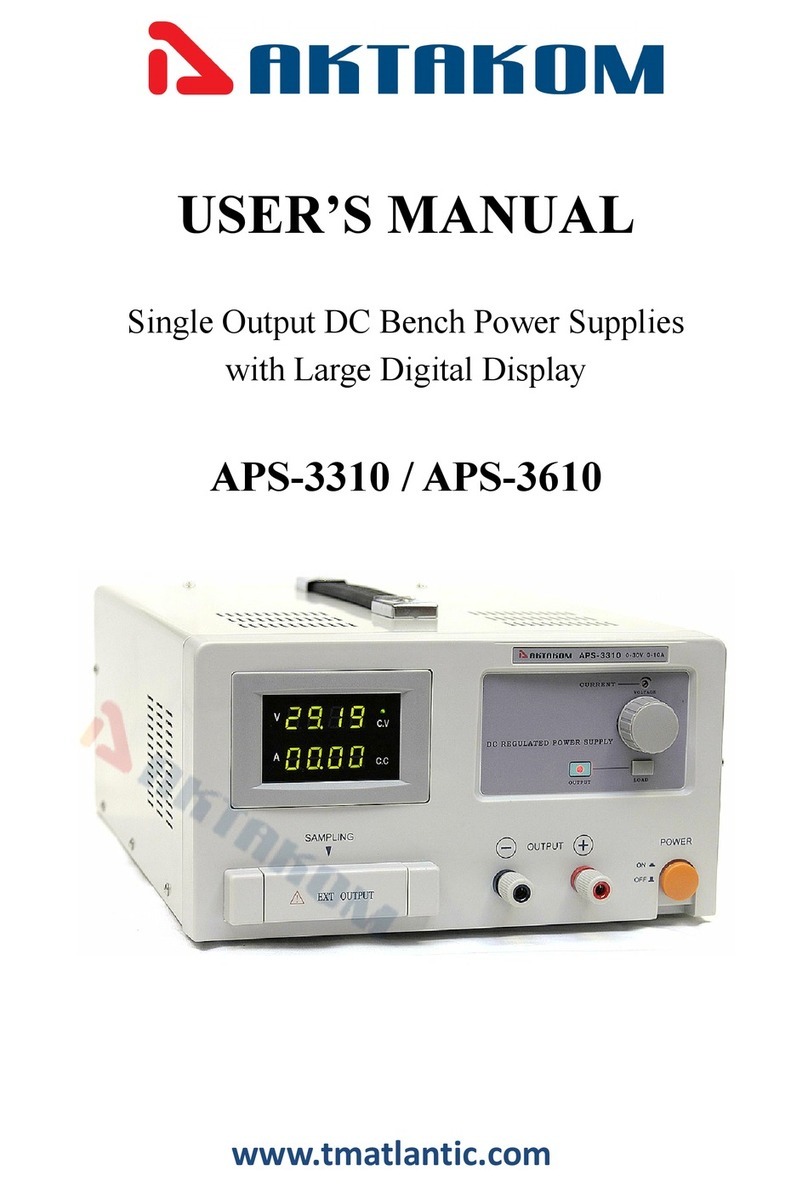
Aktakom
Aktakom APS-3310 user manual

Fairchild
Fairchild 667 instruction manual

Teledyne
Teledyne HASTINGS 200 Series instruction manual

